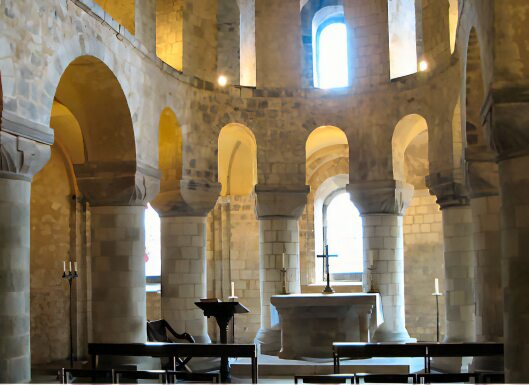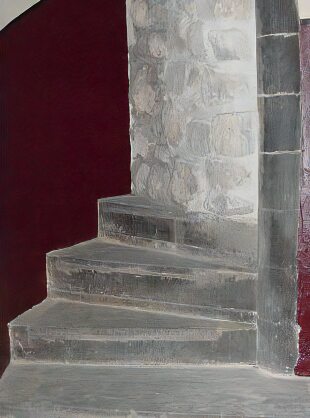Tower of London
The beautiful but austere Romanesque Chapel of St John is situated on the second floor of the White Tower and is one of the finest surviving examples of Norman church architecture.
Chapel of St. John
The Chapel measures 55 feet 6 inches long by 31 feet wide, and 32 feet high, and is vaulted with a plain arch. There are four massive columns on either side and four in the apse. Thick, round piers support unmoulded arches, notable for their simplicity, with simple carvings of scallop and leaf designs providing the only decoration.The south aisle communicated with the palace, and an upper aisle, or gallery, similarly opened into the State Apartments.
The chapel was built for William the Conqueror but he died before its completion. It was first used by his son William II. King Henry III added stained glass windows depicting the Virgin Mary and the Holy Trinity in around 1240. The chapel was also provided with such ornamentation as a gold-painted cross in Henry's reign. The Chapel of St. John's 'current bare and unadorned appearance is reminiscent of how it would have looked in the Norman era.
Staircase in the White Tower beneath which the alleged bones of 'the Princes in the Tower' were discovered
During the Peasants Revolt of 1381, early in the reign of King Richard II, Archbishop Simon of Sudbury, chancellor of England took refuge in St John's Chapel from an angry mob who broke into the tower, along with the treasurer Hales, John Legge and John of Gaunt's physician. All four of them were dragged from the altar, down the steps out of the tower gates and up to nearby Tower Hill where they were beheaded by the rebels. Archbishop Sudbury's head was later displayed on a spike on London Bridge, after the rebellion was crushed it was replaced by that of the rebel leader Wat Tyler.
Tradition states that Elizabeth of York, Queen of Henry VII, lay in state in the Chapel of St.John after dying in childbirth at the Tower in 1503. Henry VIII's eldest daughter, Queen Mary I, was betrothed by proxy to Philip of Spain in the chapel.
In 1674, workmen employed in demolishing a staircase within the White Tower, leading to the chapel of St John, made a gruesome discovery of the bones of two children in an elm chest, at around a depth of ten feet.
The bones were originally thrown aside with some rubble until their significance as the possible bones of the two 'Princes in the Tower' was recognised. Several accounts survive relating to the discovery of these bones, the following account, written on the evidence presented by John Knight, Chief Surgeon to Charles II, was published in 1677:-
"Upon Friday the ... day of July, On. 1674 ... the rebuilding of several Offices in the Tower, and to clear the White Tower of all contiguous buildings, digging down the stairs which led from the King's Lodgings to the chapel in the said Tower, about ten foot in the ground were found the bones of two striplings in (as it seemed) a wooden chest, which upon the survey were found proportionable to ages of those two brothers viz. about thirteen and eleven years. The skull of one bring entire, the other broken, as were indeed many of the other bones, also the chest, by the violence of the labourers, who....cast the rubbish and them away together, wherefore they were caused to sift the rubbish and by that means preserved all the bones. The circumstances of the story being considered and the same often discoursed with Sir Thomas Chichley, Master of the Ordinance, by whose industry the new buildings were then in carrying on, and by whom the matter was reported to the King.''
Charles II, then the reigning monarch, believing them to be the bones of the two princes, asked the architect Sir Christopher Wren design a white marble container and they were reverently placed in the Henry VII chapel at Westminster Abbey, close to the tomb of the Prince's sister, Elizabeth of York.
The White Tower PreviousNext The Chapel of St. Peter
